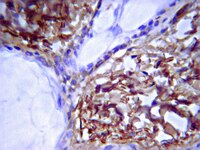Leptin promotes invasiveness of kidney and colonic epithelial cells via phosphoinositide 3-kinase-, rho-, and rac-dependent signaling pathways.
Attoub, S, et al.
FASEB J., 14: 2329-38 (2000)
2000
Show Abstract
Leptin plays a key role regulating food intake, body weight and fat mass. These critical parameters are associated with an increased risk for digestive and mammary gland cancer in the Western population. Here we determined whether leptin contributes to the invasive phenotype of colonic and kidney epithelial cells at various stages of the neoplastic progression. First, leptin potently (EC50 = 10-30 ng/ml) induces invasion of collagen gels by premalignant familial adenomatous colonic cells PC/AA/C1 and nontumorigenic MDCK kidney epithelial cells, their src-transformed counterparts, and the human adenocarcinoma colonic cells LoVo and HCT-8/S11. Leptin and its Ob-Rb receptors were consistently identified by RT-PCR and immunoblotting in these cell lines, as well as in human colonic epithelial crypts, polyps, colonic tumor resections, and adjacent mucosa. Leptin-induced invasion was effectively blocked by pharmacological inhibitors of several downstream signaling pathways involved in cell transformation, namely, JAK2 tyrosine kinase (AG490), phosphoinositide PI3'-kinase (wortmannin and LY294002), mTOR kinase (rapamycin), and protein kinases C (GF109203X, Gö6976). Accordingly, leptin induces transient elevation of the PI3'-kinase lipid products in JAK2 immunoprecipitates prepared from parental MDCK cells. The leptin effect on invasion was potentiated by the activated form of the small GTPase RhoA and was abrogated by dominant negative mutants of RhoA, Rac1, and the p110alpha of PI3'-K. Our data indicate that leptin may exert a local and beneficial effect on migration of normal colonic epithelial cells and reparation of the inflamed or wounded digestive mucosa. We also emphasize a new role for leptin, linking the nutritional and body fat status to digestive cancer susceptibility by stimulating the invasive capacity of colonic epithelial cells at early stages of neoplasia. This finding has potential clinical implications for colon cancer progression and management of obesity. | Cell Culture | 11053255
 |
Gelatinase A activation is regulated by the organization of the polymerized actin cytoskeleton.
Tomasek, J J, et al.
J. Biol. Chem., 272: 7482-7 (1997)
1997
Show Abstract
Gelatinase A (GL-A) is a matrix metalloproteinase (MMP) involved in both connective tissue remodeling and tumor invasion. GL-A activation is mediated by a membrane-type MMP (MT-MMP) that cleaves the GL-A propeptide. In this study, we examined the role of the actin cytoskeleton in regulating GL-A activation and MT-MMP-1 expression. Human palmar fascia fibroblasts and human fetal lung fibroblasts were cultured on a planar substratum or within different types of collagen lattices. Fibroblasts that formed stress fibers, either on a planar substratum or within an attached collagen lattice, showed reduced GL-A activation compared with fibroblasts lacking stress fibers, within either floating or stress-released collagen lattices. To determine whether changes in the organization of the actin cytoskeleton could promote GL-A activation, fibroblasts with stress fibers were treated with cytochalasin D. Within 24 h after treatment, GL-A activation was dramatically increased. Associated with this GL-A activation was an increase in MT-MMP-1 mRNA as determined by Northern blot analysis. Treatment with nocodazole, which induced microtubule depolymerization and cell shape changes without affecting stress fibers, did not promote GL-A activation. These results suggest that the extracellular matrix and the actin cytoskeleton transduce signals that modulate GL-A activation and regulate tissue remodeling. | Cell Stimulation | 9054450
 |
















